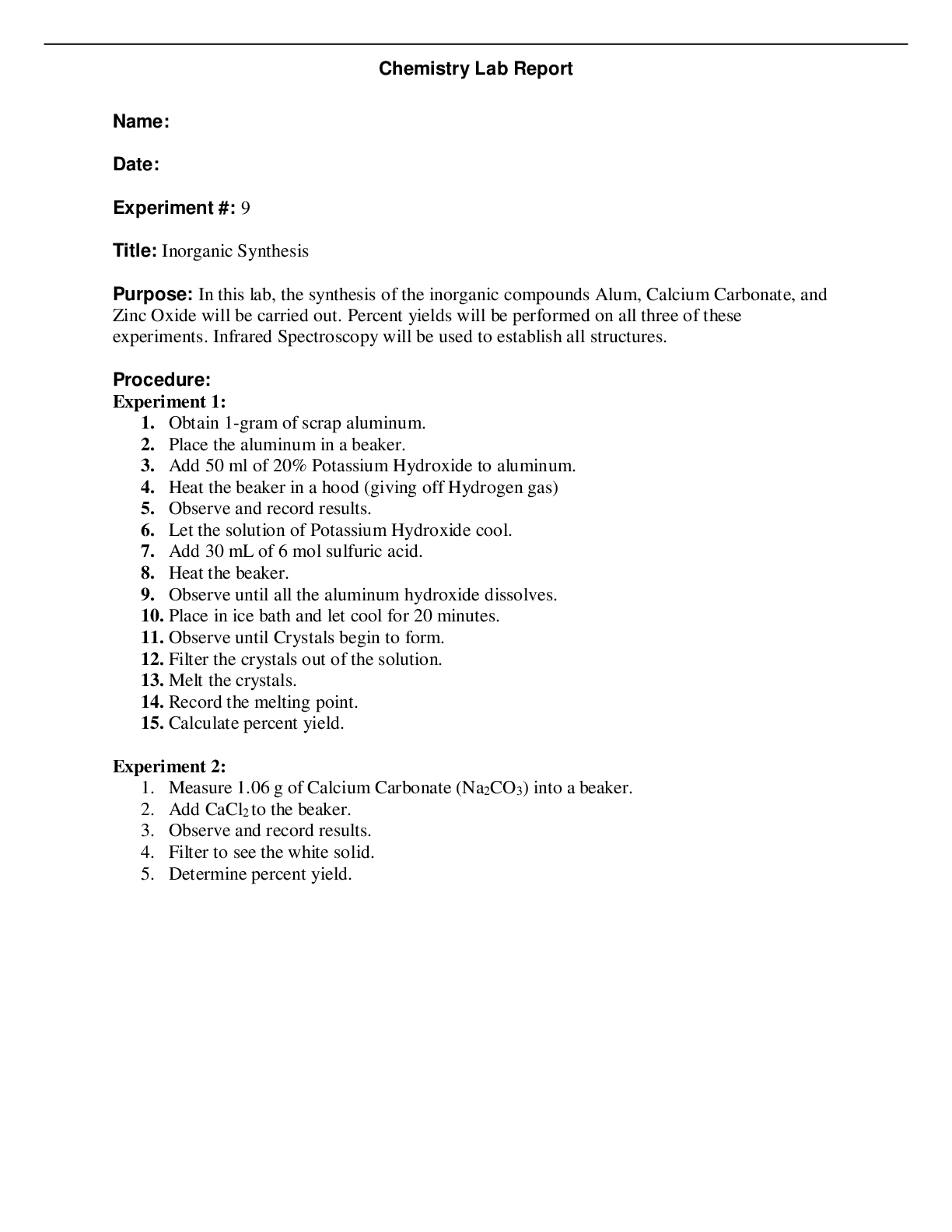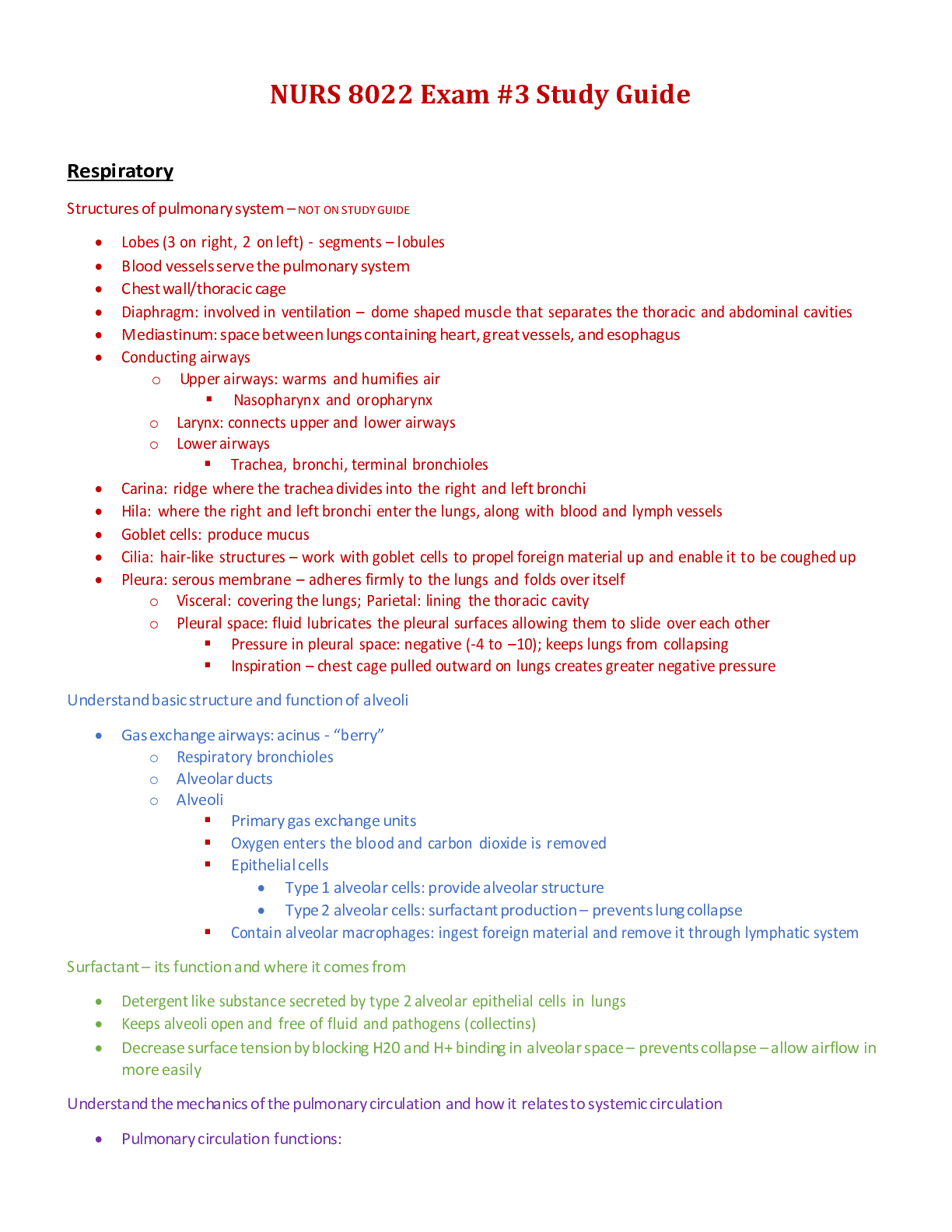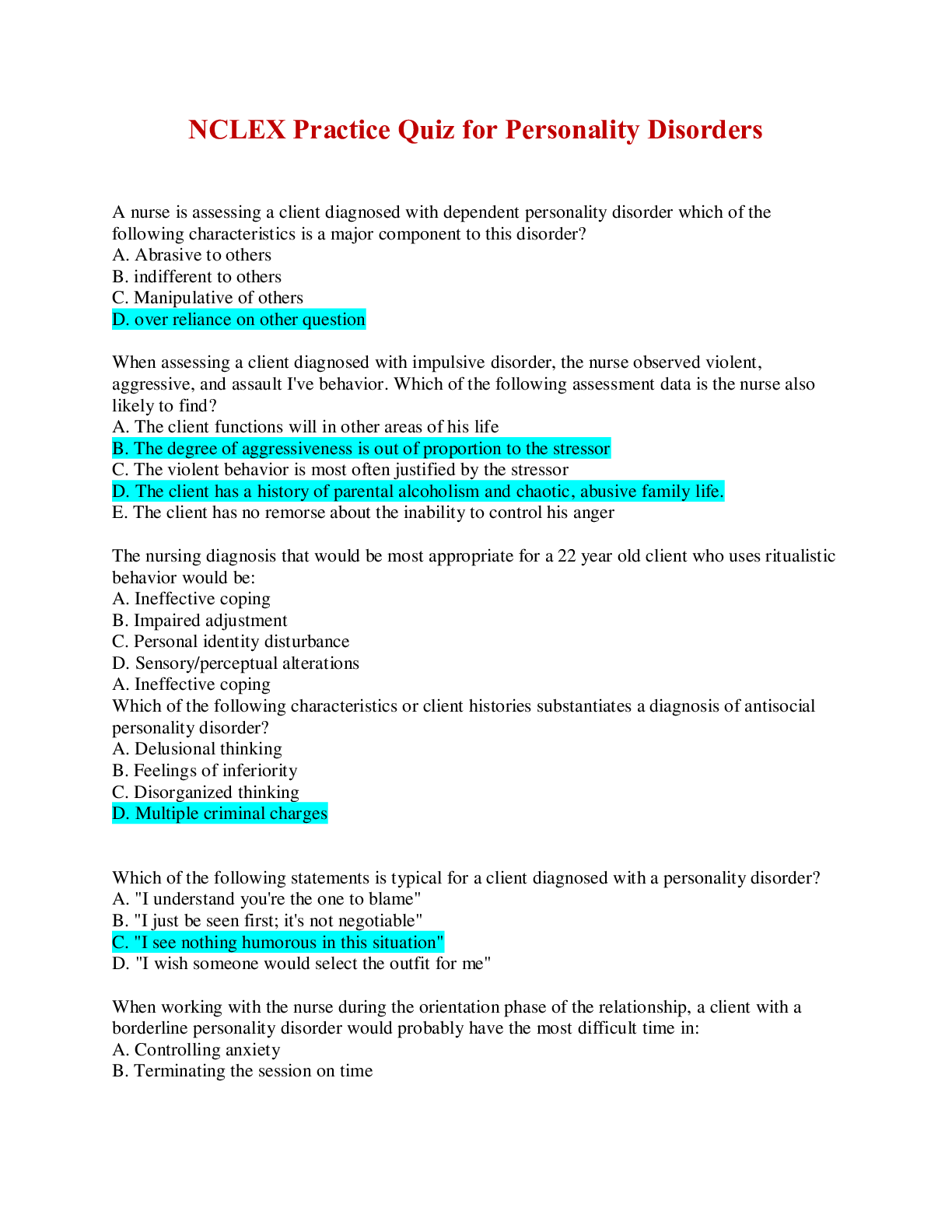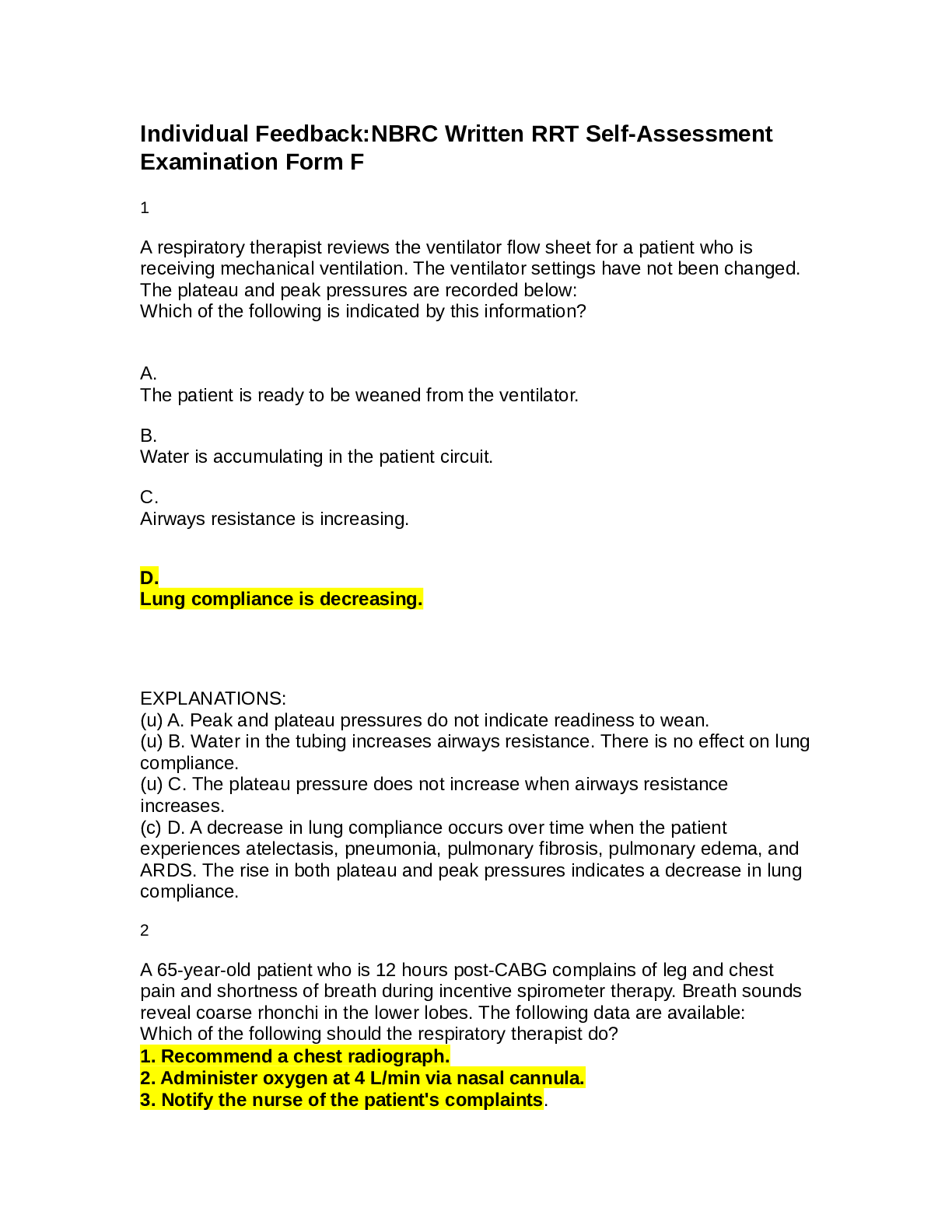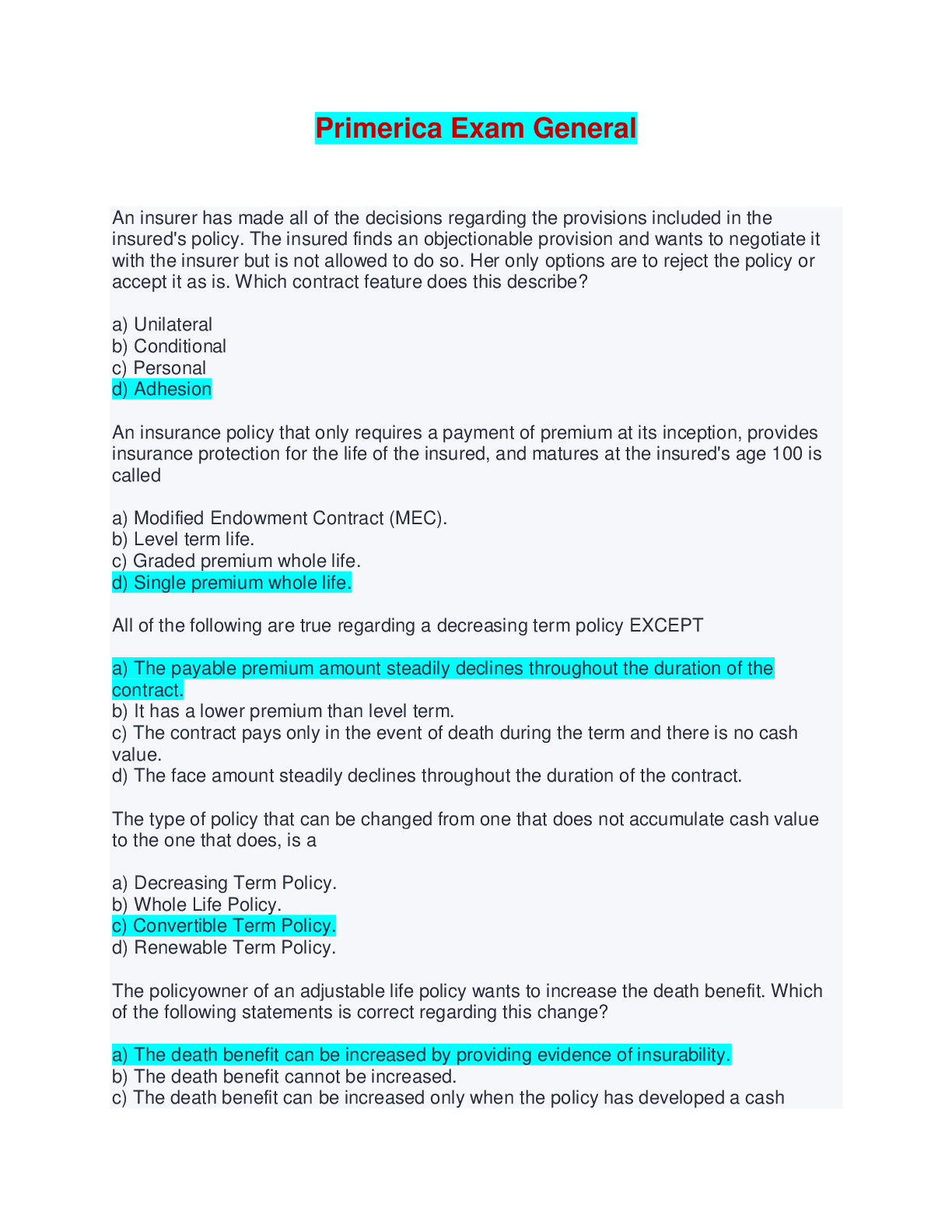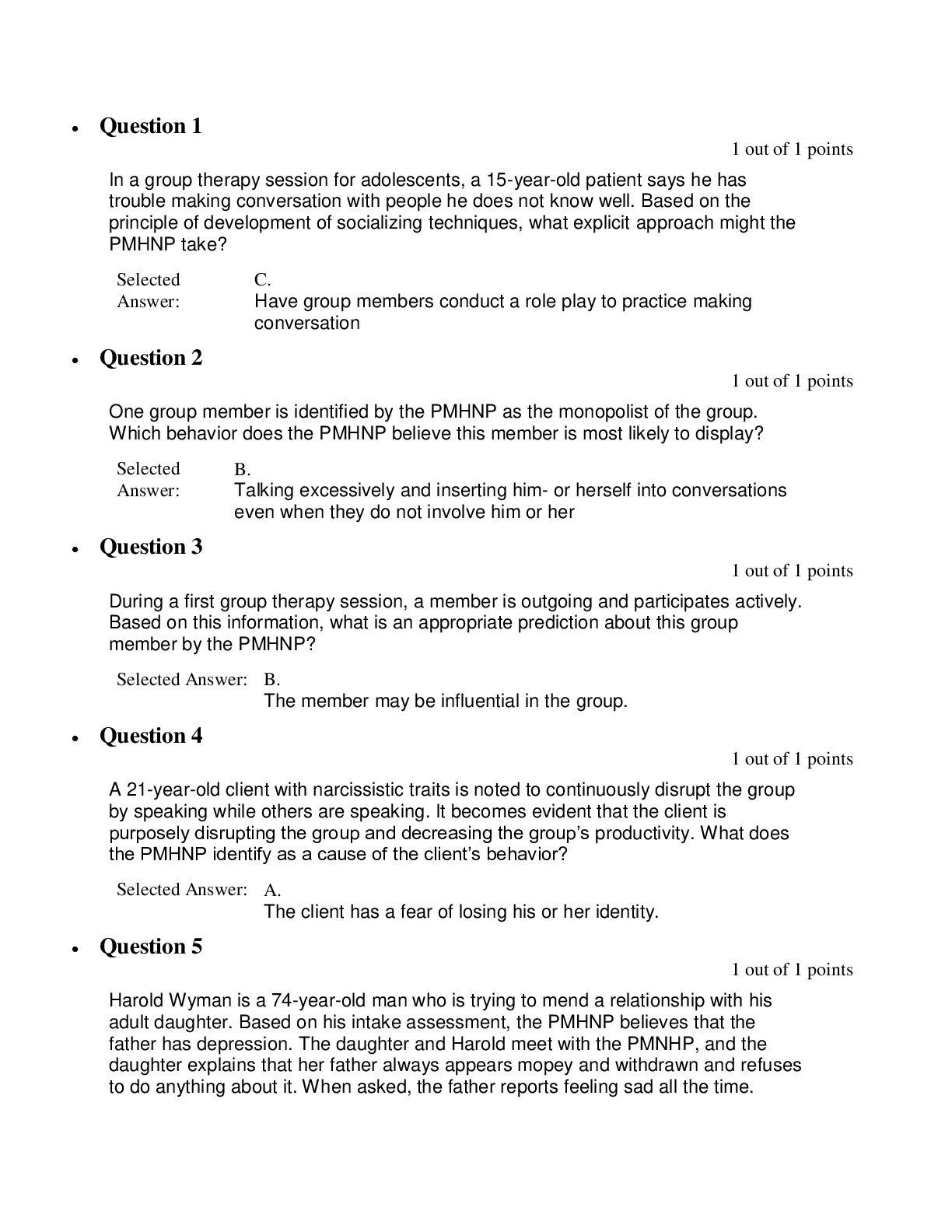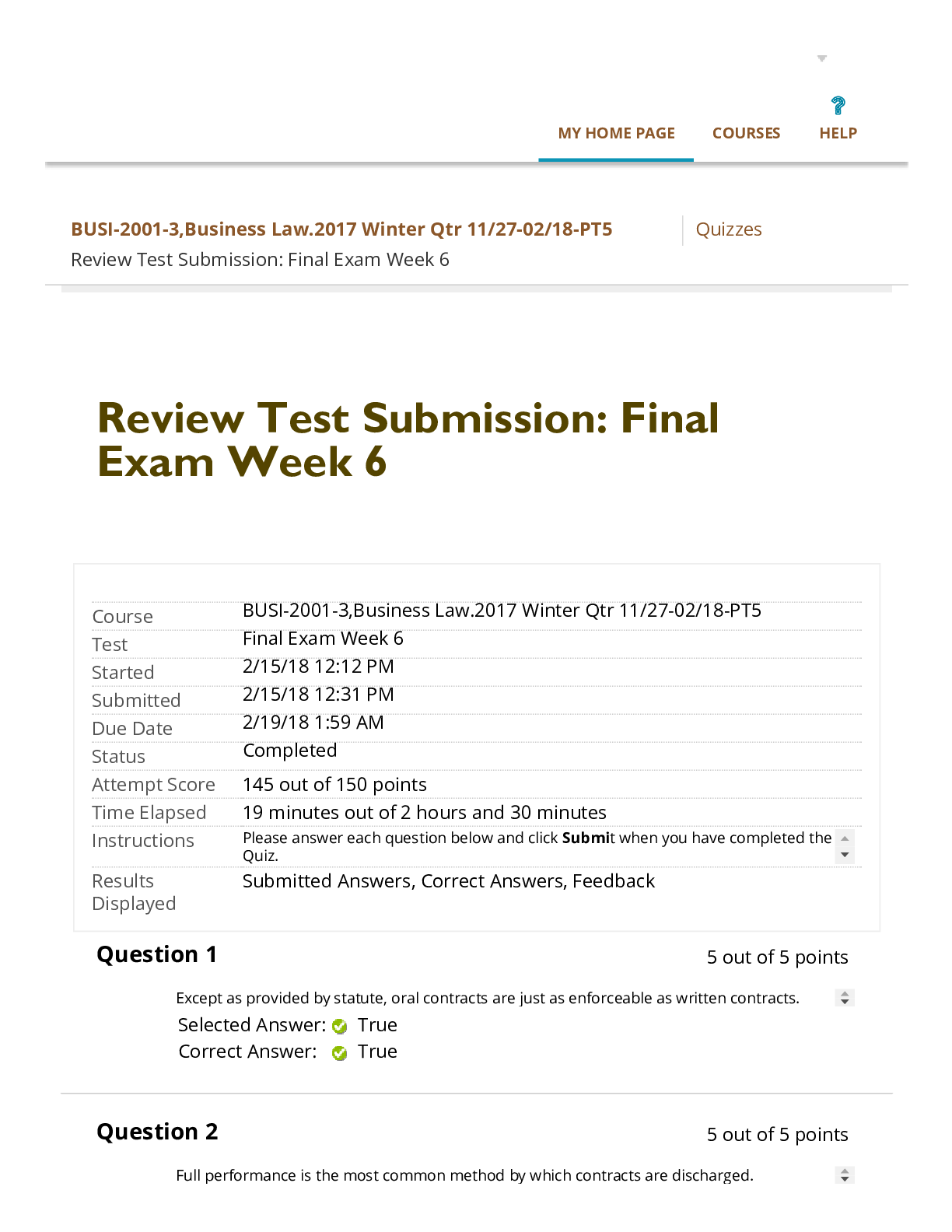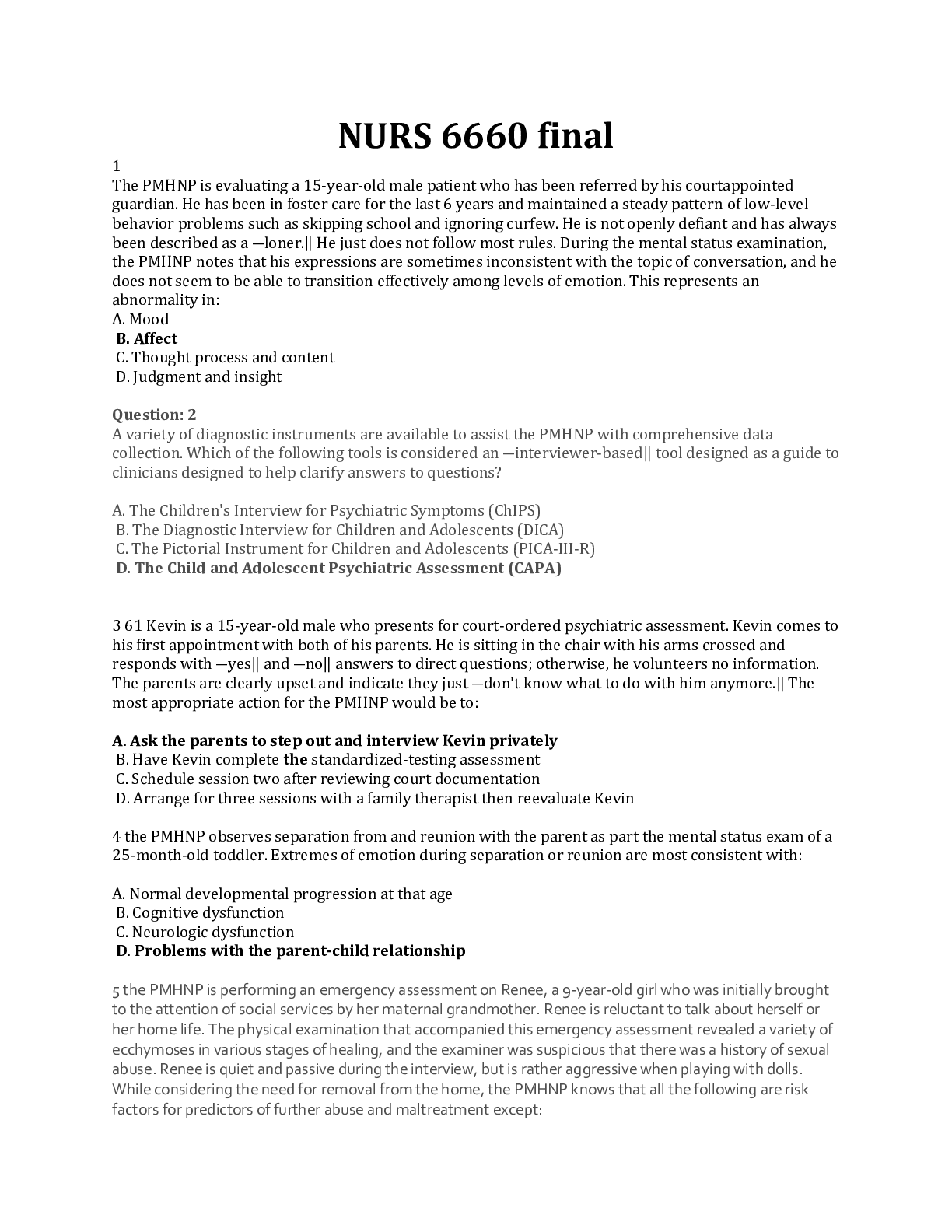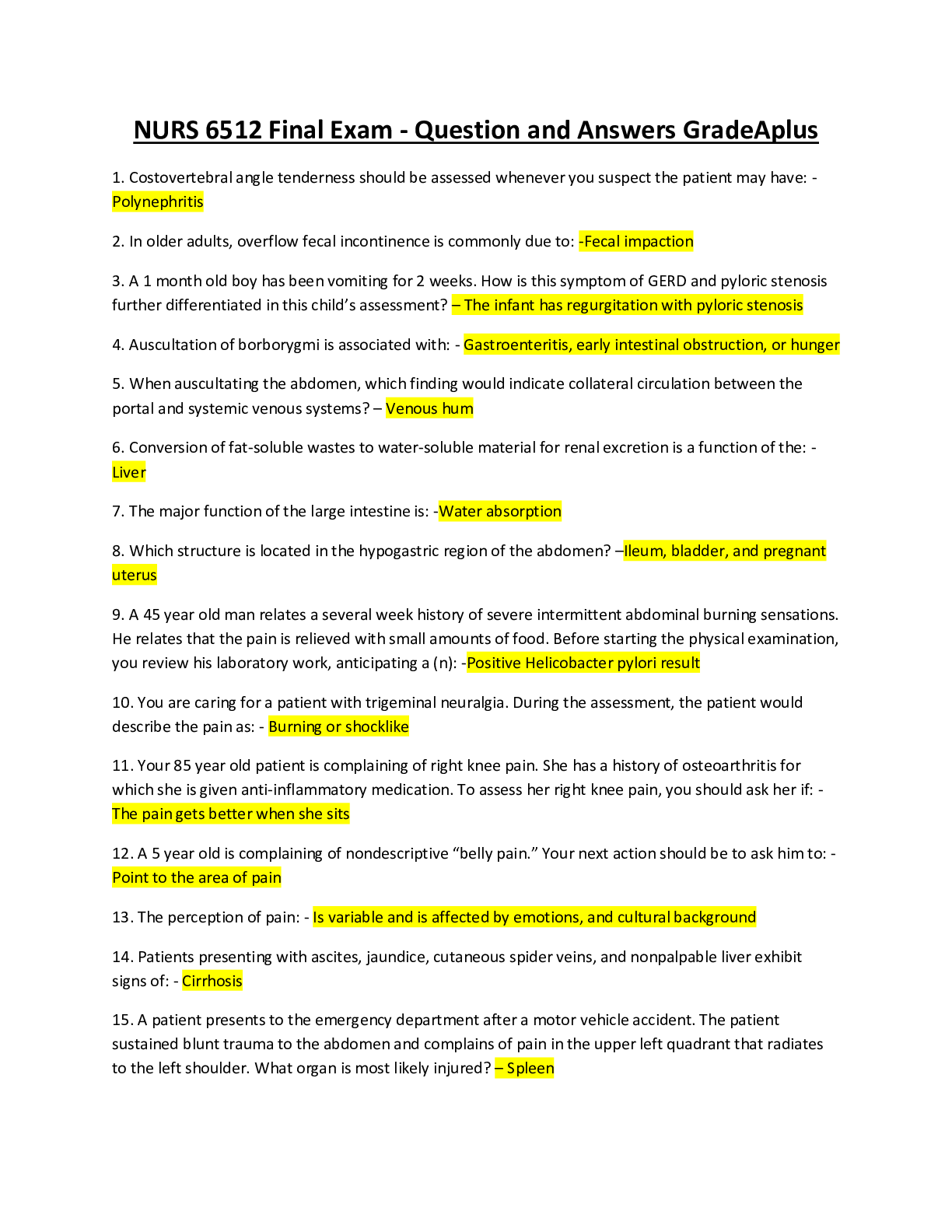NUR 205 Final Exam - Questions, Answers and Rationales (Complete Solutions)
Document Content and Description Below
NUR 205 Final Exam - Questions, Answers and Rationales (Complete Solutions) Which of the following clients is the most appropriate candidate for receiving outpatient care? A) A client whose complain... ts of irregular bowel movements have necessitated a colonoscopy B) A woman who has previously borne two children and is entering the second stage of labor C) A man who is receiving treatment for sepsis after his blood cultures came back positive D) A client with a history of depression who is currently expressing suicidal ideation Outpatient services are appropriate for clients who are medically stable but who require diagnostic testing, such as a colonoscopy. Clients in active labor and clients who are actively septic or suicidal require close monitoring and frequent interventions, which can only be safely provided on an inpatient basis. After many years of advanced practice nursing, a nurse has recently enrolled in a nurse practitioner program. This nurse has been attracted to the program by the potential to provide primary care for clients after graduation, an opportunity that is most likely to exist in which of the following settings? A) A rural health center B) A long-term care facility C) A university hospital D) A community hospital Many rural health centers employ few health care providers, and primary care is often provided by a nurse practitioner (NP). A nurse practitioner may provide care in a long-term care facility or hospital, but in these settings, the NP is less likely to be the provider of primary care to clients. Which of the following phrases best describes hospitals today? A) Focus on chronic illnesses B) Focus on acute care needs C) Primary care centers D) Voluntary agencies Hospitals have become acute care providers for people who are too ill to care for themselves at home, who are severely injured, who require surgery or complicated treatment, or who are having babies. Hospitals rarely focus on chronic illnesses, and they are not primary care centers. Hospitals are not classified as voluntary agencies. A man is scheduled for hospital outpatient surgery. He tells the nurse, "I don't know what that word, outpatient, means." How would the nurse respond? A) "It means you will have surgery in the hospital and stay for 2 days." B) "It means the surgeon will come to your home to do the surgery." C) "Why would you ask such a question? Don't worry about it." D) "You will have surgery and go home that same day." In addition to providing acute care, hospitals have many services for outpatients (those who require health care but do not need to stay in the facility). Clients who have outpatient surgery have the procedure, return to their hospital room for recovery, and then are discharged home on the same day. A nurse in a walk-in health care setting provides technical services (e.g., administering medications), determines the priority of care needs, and provides client teaching on all aspects of care. Which of the following terms best describes this type of health care setting? A) Hospital B) Physician's office C) Ambulatory center D) Long-term care Nurses in ambulatory care centers (walk-in clinics) provide technical services (e.g., administering medications), determine the priority of care needs, and provide teaching about all aspects of care. Nurses employed in hospitals have many roles, including manager of other members of the health care team providing client care, administrator, nurse practitioner, clinical nurse specialist, patient educator, in-service educator, and researcher. In physician's offices, advanced practice registered nurses (APRNs), nurse practitioners, midwives, or clinical nurse specialists work independently or collaboratively with physicians to make assessments and care for clients who require health maintenance or health promotion activities. Long-term care provides medical and nonmedical care for people with chronic illnesses or disabilities. Nurses who are employed in home care have a variety of responsibilities. Which of the following is one of those responsibilities? A) Provide all care and services B) Maintain a clean home environment C) Advise clients on financial matters D) Collaborate with other care providers Nurses who provide care in the home make assessments, provide physical care, administer medications, teach, and support family members. They also collaborate with other health care providers in providing care and services. Home care nurses do not provide all care and services, maintain a clean home environment, or advise clients on financial matters. Which of the following is true of long-term care facilities? A) They provide care only to older adults. B) They provide care for homeless adults. C) They provide care to people of any age. D) They provide care only for people with dementia. Long-term care facilities provide health care, and help with the activities of daily living, for people of any age who are physically or mentally unable to care for themselves independently. They do not provide care only to older adults or those with dementia, although they do care for those populations as well as others. They do not provide care to homeless persons. A grade school is preparing a series of classes on the dangers of smoking. Who would be most likely to teach the classes? A) A community health nurse B) An outside consultant C) A teacher D) The school nurse School nurses provide many different services, including maintaining immunization records, providing emergency care, administering prescribed medications, conducting routine screenings, conducting health assessments, and teaching for health promotion (e.g., the dangers of smoking). Although any of the other choices may provide teaching, it is the nurse who primarily provides health-related teaching. An elderly woman has total care of her husband, who suffers from debilitative rheumatoid arthritis. The couple voices concern over the pain and stress associated with the condition. What type of care might the nurse suggest to help the couple? A) Primary care B) Respite care C) Bereavement care D) Palliative care The goal of palliative care is relief from the symptoms, pain, and stress of a serious illness, and to improve the quality of life for both the client and the family. The main purpose of respite care is to give the primary caregiver some time away from the responsibilities of day-to-day care. Primary care is found in acute care settings and physicians' offices. Bereavement care is provided to families following the death of a family member. What population do hospice nurses provide with care? A) Those requiring care to improve health B) Children with chronic illnesses C) Dying persons and their loved ones D) Older adults requiring long-term care Hospice is a program of palliative and supportive services providing physical, psychological, social, and spiritual care for dying persons, their families, and other loved ones. Hospice nurses do not implement care to improve health, focus on children with chronic illnesses, or care for older adults in long-term care. Who provides physicians with the authority to admit and provide care to clients requiring hospitalization? A) The health care institution itself B) Board of Healing Arts C) American Medical Association D) State Board of Nursing Physicians are granted the authority to admit clients to a health care agency or institution, and to provide care in that setting by the health care agency or institution itself. They are licensed to practice medicine by a state medical board, not a state board of nursing or a board of healing arts. After a stroke, a client is having difficulty swallowing. The nurse may make a referral to what member of the health care team? A) Physical therapist B) Speech therapist C) Social worker D) Respiratory therapist In addition to providing services to improve oral communication, a speech therapist may also diagnose and treat swallowing problems in clients who have had a head injury or stroke. A physical therapist assists with musculoskeletal and neurological impairments, a social worker is educated to help clients with economic and social issues, and a respiratory therapist provides treatments to improve breathing. Medicare uses a prospective payment plan based on diagnosis-related groups (DRGs). What are DRGs? A) Locally supported health care financing, usually by donations B) A public assistance program for low-income individuals C) Predetermined payment for services based on medical diagnoses D) A private insurance plan for subscribers who pay a copayment Medicare, based on DRGs, pays a hospital a fixed amount that is predetermined by the medical diagnosis or specific treatment rather than by the actual cost of hospitalization and care. This plan was put into effect in an effort to control rising health care costs. It is not supported by donations; it is not a public assistance program or a private insurance plan. A client has a private insurance policy that pays for most health care costs and services. Why is this plan called a third-party payer? A) The insurance company pays all or most of the costs. B) The family of the client is required to pay costs. C) The client gets the bill and pays out-of-pocket costs. D) Medicare and Medicaid will pay most of the costs. Insurance for health care may be financed through private insurance, in which members pay a monthly premium. These plans are called third-party payers, because the insurance company pays all or most of the cost of care. A person receiving health care insurance from his employer knows that he should check the approved list of contracted health care providers before seeking services, in order to receive them at a lower cost. What type of insurance is most likely involved? A) Medicaid B) Preferred provider organization C) Health maintenance organization D) Long-term care insurance Preferred provider organizations (PPOs) allow a third-party payer (agencies that pay health care providers for services provided to individuals, such as a health insurance company) to contract with a group of health care providers to provide services at a lower fee in return for prompt payment and a guaranteed volume of clients and services. Although clients are encouraged to use specific providers, they may also seek care outside the panel without referral by paying additional out-of-pocket expenses. What is the primary focus of health care today? A) Care of acute illnesses B) Care of chronic illnesses C) Health promotion D) Health restoration In the past, health care focused on the treatment of illnesses rather than prevention through health promotion, because preventive strategies were not covered by health insurance. Health awareness and the desire to be involved in one's own health care have strongly influenced the delivery of health care services in our society. What is one way in which nurses can help shape health care reform? A) Do their job and do it well B) Refuse to participate in organizations C) Support legislation to improve care D) Become a member of a support group There are many ways in which nurses can help shape health care reform, including supporting legislation to improve care. Nurses are expected to do their job well. Refusing to participate in organizations and/or becoming a member of a support group will not help shape health care reform. Which of the following health care insurance programs is most suitable for a client 68 years of age? A) Medicaid B) Medicare C) Capitation D) AmeriCare Medicare is a federal program that finances health care costs of persons 65 years and older, permanently disabled workers of any age and their dependents, and those with end-stage renal disease. The system is funded primarily through withholdings from an employed person's income. Capitation is a reimbursement strategy in managed care organizations. AmeriCare is a type of private insurance. Capitation and AmeriCare are not the preferred providers for the client, considering the client's old age. Medicaid is a federal program that is operated by the states, and each state decides who is eligible and the scope of health services offered. In Medicaid, eligibility may be decided by the state, which is not the case in Medicare. Nurses who assist clients to deal holistically with their health care needs at the end of their lives work primarily in which health care delivery system? A) Acute care B) Primary care C) Hospice D) Rehabilitation The opportunity to help people maintain their ability to remain at home and deal holistically with their health and family needs at the end of their lives is home health hospice care. What is one of the most significant trends in health care today? A) Increased length of hospital stays B) Shift from hospitals to community-based care C) Emphasis on disease management D) Narrowing of the areas for nursing practice The shift to community-based care is related to the public's desire to participate more actively in health care decisions, issues, and choices. Long-term care is often needed for the elderly client. Select all the services that may be provided to the resident in a long-term care facility. A) Assistance with activities of daily living B) Immediate post-op care C) Mental disability services D) Nonmedical care for chronic illness E) Day care meals and services Acute/immediate post-op care is a specific need/care immediately following surgery/ procedures and is completed at the facility. Day care meals and services are separate services and are not provided to residents in a long-term-care facility. All the others are part of what a long-term care facility provides. The nurse working in the hospital understands the changes that have resulted in shorter hospital stays, with a focus on acute care needs of the client. Which of the following factors influence shorter hospital stays? Select all that apply. A) Federal regulations for health care reimbursement policies. B) Increased emphasis on preventive care. C) Improvement in treatment of illness. D) Patients realize that longer stays result in infections and other problems. Shorter hospital stays direct the focus on the acute care needs of the client and have resulted from improved treatment of disease, increases in preventive care, and federal regulations and other health care reimbursement policies. Longer hospital stays are often the result of infection, as this factor is not related to shorter hospital stays. Medicare reimburses in-hospital costs based on a set payment for a diagnostic related group (DRG). This means the hospital is reimbursed for a fixed amount based on the diagnosis and projected cost for care. As a result of this system the hospital can make a profit or a loss. Select the responses that describe when a profit for care of the client can be achieved. A) All of the hospitalization charges are less than projected. B) The client receives incompatible blood so the hospital does not get charged for it. C) The client is discharged before the approved discharge date. D) The nursing care results in the client reaching outcomes for recovery, without complication, after the projected timetable The hospital will make a profit when cost of hospitalization is less than the reimbursement assigned for the severity of illness and projected care costs. If the client is discharged earlier than projected the hospital keeps the total reimbursed. Incompatible blood is a preventable error, for which the hospital is not reimbursed. Reaching outcomes after the approved time results in additional cost to the hospital. Hospice nurses provide care in a variety of settings, including clients' homes, long-term-care facilities, and hospice residences. After the client dies, what happens next? A) The hospice services are provided to the families of the former residence clients only. B) The hospice services continue for family and friends during the bereavement period, up to one month after the death. C) The hospice nurse continues to care for the client's family for up to one year. D) Nurses assist the family to work through their grief during the period of mourning. After the death of the patient, the hospice nurse continues to care for the client's family during the bereavement period for up to one year. Nurses help the family to work through their loss. One of the newest concepts in providing long-term care is called aging in place. What is the best description of this type of care? A) provided within the health care community where they live. B) Clients move into the nursing home, and access more and more services as required in the same facility. A long-term-care facility, associated with a hospital, that provides acute care services as needed so the client can return C) Clients move to an independent living apartment or home, then have access to increasing health care services as needed, to long term care. D) Clients are maintained in their own homes with home health care. The best description of "aging in place" is the type of care where the client moves into an independent living space, and then has access to more services, such as assisted living and/or skilled care, that are part of the health care community in which they live. Health care is constantly changing and becoming more complex. Select the answers that describe clients as health care consumers today. Select all that apply. A) They often have health information obtained from the Internet. B) They prefer to control the decisions made about their own health care. C) Most are less concerned about health care costs as long as they receive good care. D) They express concern regarding access to care and the quality of service. E) They have helped develop clients' rights and cost-containment measures. Health care consumers are increasingly more knowledgeable about health, and prefer to control the decisions about their care. They express concern about access to services, and the cost and quality of care. They question duplication of services, and are actively engaged. They have helped to develop client rights and cost-containment measures as protections for clients in health care settings. Today clients are surveyed regarding their experiences with doctors and nurses in hospitals. The Public Health Service (PHS) is a federal agency of the U.S. Department of Health and Human Services. The professional nurse is aware that the services provided by the PHS include which of the following? Select all that apply. A) Care to migrant workers B) Care in federal prisons C) Veterans Administration (VA) hospitals D) Indian Health Services The Public Health Services provides all of these services and others, except the Veterans Administration Hospitals. VA hospitals are supported by government-operated health care, not the PHS. Health care costs are increasing as technology and related services increase. Patients interact with many health care providers, such as RNs, LPNs, physicians, physical therapists, medical technologists, radiation technologists, specialists, and others employed in health care. As a result of the complexity of care and multiple providers, health care is becoming fragmented. What are the major results of fragmented care? A) Less confusion for clients regarding treatment. B) Increased medication errors. C) Clients receive more specialized care. D) Lack of continuity of care. Fragmented care increases health care costs and the number of providers/specialists seeing the client. A lack of continuity of care often results, increasing the client's confusion, and medication errors may increase. Although clients often receive specialized care and services, there may be conflicting care plans. A nurse is making a visit to a client in the home. As a home health care nurse you may be expected to accomplish which of the following? A) Complete an assessment on each visit. B) Provide support to the client and family. C) Administer treatments and medications. D) Document actions regarding patient, activities, and progress. E) Communicate and collaborate with other members of the health team. All of the above. Home health care nurses may provide all of these activities in the home setting. Nurses work with various members of the health team. The nurse understands that the role of the hospitalist is best described as: A) the doctor who admits the patient, assumes the management of the patient's care, and maintains communication with the primary physician while the patient is hospitalized. B) the physician who manages the patient's care in emergency and intensive care units only. C) the doctor who notifies the primary physician that their patient has been admitted to the hospital, and transfers care to a referral specialist. D) the specialist who admits the patient to hospital, and returns care to the primary physician for all other referrals and services. The hospitalist is a physician who provides care to the patient in the emergency room and after admission to the hospital. The hospitalist communicates with the patient's primary doctor, but manages the hospital care. A nurse has been hired to work as an occupational health nurse. In this position as a registered nurse, what will this nurse provide? A) Occupational therapy to schoolchildren. B) Education and safety programs in industrial settings. C) Assessment and motivation services to the unemployed. D) Activities to assist patients with ADLs in homeless shelters. Industrial settings is the best answer to define/describe occupational health nursing, which focuses on employee safety and health-promotion programs. The other options do not address health needs in an employment setting. In providing nursing care, it is most important to perform which of the following actions? A) Administration of prescribed medication B) Implementation of physician's orders C) Evaluation of client's responses D) Coordination of care with the health care team Nurses have moved from simply observing and giving prescribed medications to coordinating clinical information for the entire health care team. The U.S. system of health care is based on an ability to pay for care, which leaves millions of people uninsured or underinsured, with inadequate access to health care. Nurses are often presented with ethical dilemmas when caring for patients and families. Which of the following is an example of an ethical dilemma? Select all that apply. A) All clients are entitled to care, whether they can pay or not, because health care is a right. [Show More]
Last updated: 1 week ago
Preview 1 out of 42 pages
Instant download

Loading document previews ...
Buy this document to get the full access instantly
Instant Download Access after purchase
Add to cartInstant download
Reviews( 0 )
Document information
Connected school, study & course
About the document
Uploaded On
Jun 15, 2024
Number of pages
42
Written in
Additional information
This document has been written for:
Uploaded
Jun 15, 2024
Downloads
0
Views
12



